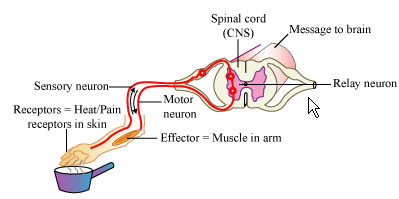what is a reflex action? explain briefly its mechanism in humans. three mark question.
Reflex Action is defined as an unconscious, automatic and involuntary response of efforts, i.e., muscles and glands, to a stimulus, which is monitored through the spinal cord.
Mechanism of Reflex Action:
It involves the following steps:
(i)Receptor organ like skin perceives the stimulus and activates a sensory nerve impulse.
(ii)Sensory organ carries message in the form of sensory impulse to the spinal cord.
(iii)The spinal cord acts as modulator. The neurons of spinal cord transmit the sensory nerve impulse to motor neuron.
(iv)Motor nerve conducts these impulses to the effectors like leg muscles which responds by pulling back the organ away from the harmful stimulus.
- 20
When a receptor is stimulated, it sends a signal to the central nervous system, where the brain co-ordinates the response. But sometimes, a very quick response is needed, one that does not need the involvement of the brain. This is a reflex action. Reflex actions are rapid and happen without us thinking. For example, you would pull your hand away from a hot flame without thinking about it. The diagrams below show each stage of the reflex arc. The yellow and green shape top rightof each diagram is a cross-section through the spine, as it would appear if you looked down through the head of the man whose shadow you see.
- 7

- 4
Reflex actions are loosely defined as any action that the body performs unconsciously. There are several different kinds of reflex actions, including some that are responses to external stimuli and others that regulate body organs and functions. There is also a theoretical class of reflex actions that can be learned, but the existence of these and the mechanism behind them is debated.
Many reflex actions happen in response to external stimuli, and most of these actually work without any involvement from a person’s brain. For example, if a person trips at a campsite and his hand falls into the campfire, he will quickly retract it without even thinking. This happens because the nerve signal from the injury travels through the body—when it reaches the spinal cord, it triggers an automatic response before the brain can ever get involved. The spinal cord reacts by sending back another signal that causes the person to automatically pull his hand away from the fire.
This kind of response is also responsible for the well-known knee-jerk reflex that doctors use to test a person’s nervous system. In that case, the purpose of the reflex is to help a person stay balanced when walking. Most of these kinds of reflexes exist to protect people from injury or deal with things that require immediate action. For example, people blink when something is flying towards their eyes, and this sometimes happens so fast that people don’t even realize they’re doing it.
Another kind of reflex involves the body’s ability to regulate basic functions like the heart beat and breathing. The brain keeps track of all this and keeps it going without a person’s awareness, and this is generally necessary for survival. The main thing that separates this type of reflex action is that the there is no requirement for external stimulation.
Some scientists have theorized about another kind of reflex action called a conditioned reflex. These involve a learning process where people experience something enough times and eventually develop a reflexive response to it. Unlike most reflexes involving external stimulation, these would involve the brain directly. The idea for this came from a Russian scientist named Ivan Pavlov who figured out that it was possible to make a dog salivate when it hears the sound of a bell by consistently ringing a bell right before feeding it. Scientists are generally in agreement that these sorts of reactions exist, but there is some debate about whether or not they should be called reflexes.
- -3
The automatic action or response provoked by a stimulus is known as a reflex action. The reflex actions, however, show sudden responses and do not involve any thinking.

- -4

